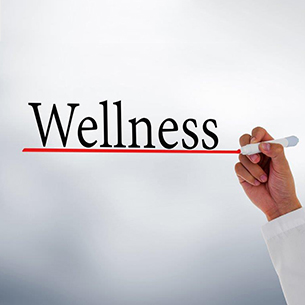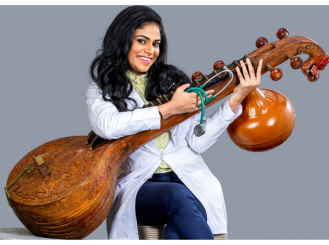By Tara Rajendran, MBBS, MFA
Way too many people are successfully concealing the scars from unfathomable mental trauma as several work cultures romanticize over-working and stigmatize burnout. This reminds me of kintsugi, the Japanese art of mending cracked pottery using magnificent powdered gold, accentuating the imperfections as a critical element of its unique history rather than disguising them. The intimate metaphoric narrative is to celebrate the beauty of survival and fortitude. Kintsugi offers a refuge from what the modern work culture has indoctrinated us: worshipping infallibility.
Where Is Your Powdered Gold?
My 4-year-old mind was inquisitive about how music wafting out of an old-school red stereo radio alleviated my bedridden grandmother's anxiety, while she was ailing with acute lymphoblastic leukemia. Witnessing music's salubrious effects, my uncle put me into vocal and instrumental classical Indian music lessons in 1998, the same year Grandma left us. It was hard to tell whether it was the astounding rhythmic intricacies or wandering through the element of emotions invoked by the melodic improvisations that impressed my 5-year-old imagination the most. Growing up, I had fairly diverse interests owing to my isolated and rustic childhood. I read and wrote extensively and indiscriminately; short stories particularly enthralled me.
What learning and creating music for over two decades enabled me to do was to express myself accurately at every phase. I might be biased, but I would say I could articulate my vulnerability and pathos the most through music, which remarkably was cathartic when I confronted physician burnout a few years ago. I was working on a musical piece for a human rights arts festival on the theme of domestic violence on women, which is a cause I connect with viscerally. I was angered by the violence against women. I used melodic and rhythmic improvisations to illustrate the feelings of anger and vehemence effectively.
Writing connected me with my old lost self. The other day, I was attempting to vividly describe a slug that my character found over a water tap. This transported me to a montage from childhood; pulling newborn slimy edible white mushrooms with my mother from freshly wet soil from last night's rain and thunderbolts. Slugs are as slimy as village mushrooms. Those shrieking crickets, the petrichor, and the cold breeze. Goosebumps! (Ah, not going to lie, while writing, I did use the assistance of heavy monsoon sounds from YouTube). I had never visited this soothing memory ever before and it made me genuinely happy and calm. Often we revisit our own memories while narrating, to give meaning and relatability to instances and characters. This is like building a bridge to ourselves. Creating a whole new world through stories with palpable characters is a sacred escape. It is like walking through a delightful, brief, and well-designed lucid dream.
Why Should You Care?
Physician burnout and suicides are on the rise globally and were attaining epidemic levels well before March 2020.1 Burnout may lead to depersonalization, cynicism, and compassion fatigue. Given the heterogeneity of health care infrastructures worldwide, it is further challenging to gauge the depth of the iceberg. While contributing factors may broadly vary, and some may not be immediately modifiable, a few individual- and institutional-level interventions may potentially ameliorate burnout, one of which is the incorporation of creative arts.
Researches report that 45 minutes of visual art-making using collage materials, modeling clay, and/or markers for over 4 months resulted in a statistically significant lowering of cortisol levels in 75 percent of participants.2 Regular hourly narrative medicine workshops conducted for a year among obstetrics and gynecology residents showed the participants with high attendance had decreased burnout on the Emotional Exhaustion sub-scale.3 Creative expression in any form may potentially help reacquaint oneself and enhance resilience.
If you have relished a form of creative expression at any stage in your life and kept it on the back burner, there would never be a better time to embrace it than today. You don't need to be Claude Monet or Madonna. Stick-person sketchers and bathroom singers are welcome here. Frequent recalibration and self-reflection using art will make one self-aware. Self-care will only come from respectful acceptance of suffering, and this would re-humanize our worlds.
At the institutional level, building regular creative expression programs that bring individuals from various health care realms together will enhance a sense of community and relatability. This fosters a sense of connection that can potentially mitigate low self-esteem, isolation, anxiety, and depression. I regularly attend two organizational-level weekly creative art programs, one on music and the other, writing; they substantially healed me from post-sequential-academic-manuscript-rejection glooms. It helps to hear, “Me too.” Each of us deserves a community that encourages us, that says, “Good Lord, you are brilliant at setting scenes and describing characters!” I began to believe in myself as a fiction author. A slight panning of vantage points, from academic writing to fiction, along with a generous pinch of reaffirmations, is all it took to be a published author! Last year, I wrote and published five short stories, and I cannot stress enough the creative art community's contribution in bolstering my self-esteem.
All of us are like broken Japanese potteries. Perfect imperfections. How meaningful would it be if, instead of disguising our fractures, we rejoin our conspicuous cracks using our artistic gifts?
Embrace your creative outlets, now more than ever!
Dr. Rajendran is a physician-musician and TEDx speaker. She is currently pursuing a PhD in classical Indian music at Annamalai University, Chidambaram, India. She is the founder of “Oncology and Strings,” a leading advocacy lecture-concert program advocating the importance of inculcating music into palliative oncology infrastructure. Follow her on Twitter @TaraRajendran. Disclosure.
References
- The Lancet. Physician burnout: a global crisis. Lancet. 2019;394:93.
- Kaimal G, Ray K, Muniz J. Reduction of Cortisol Levels and Participants' Responses Following Art Making. Art Ther (Alex). 2016;33:74-80.
- Winkel AF, Feldman N, Moss H, et al. Narrative Medicine Workshops for Obstetrics and Gynecology Residents and Association With Burnout Measures. Obstet Gynecol. 2016;128 Suppl 1:27S-33S.




Recent posts